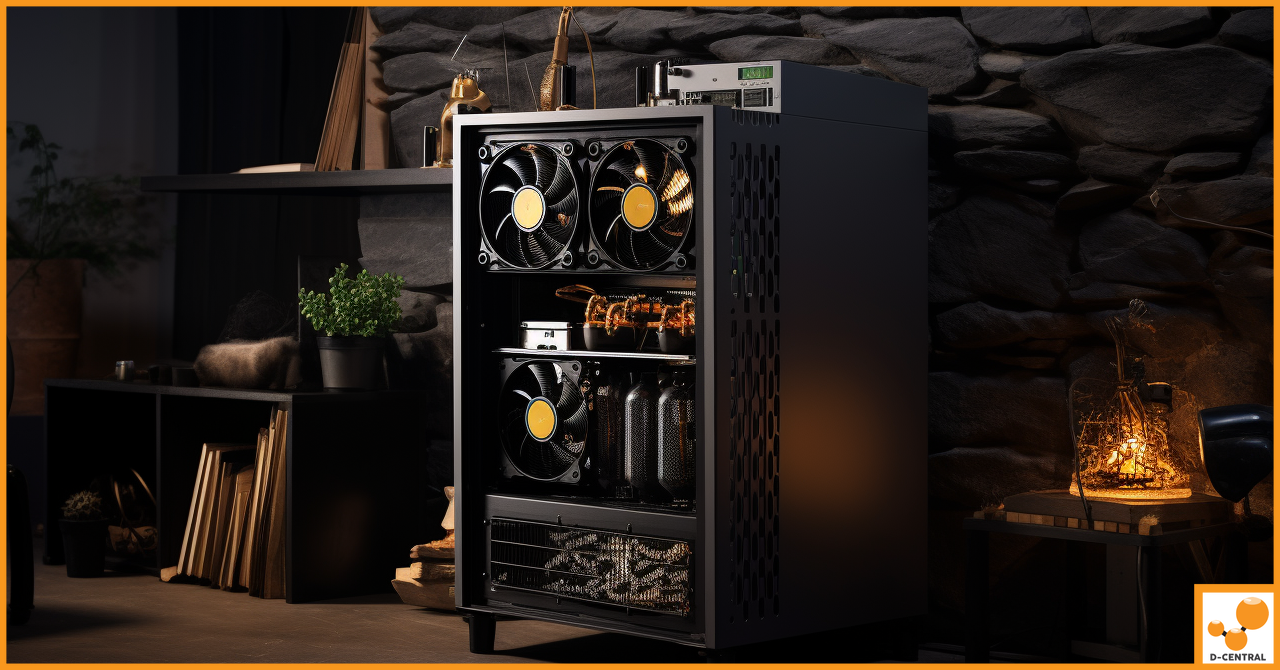
Unraveling the Political-Financial Complex: Power, Profit, and Global Impact
The intersection of politics and finance has given rise to what is commonly referred to as the political-financial complex—a term
4479 Desserte Nord Autoroute 440, Laval, QC H7P 6E2

In the vast digital realm of cryptocurrencies, Bitcoin stands as the pioneering force that ushered in a new era of decentralized finance. Its underlying technology, blockchain, is powered by a decentralized network of computers, known as miners. These miners validate and record transactions on the blockchain, ensuring the security and integrity of the entire system.
Over the years, the Bitcoin mining landscape has undergone significant transformations. What began as a hobby for tech enthusiasts, using simple CPUs in the early days has now evolved into a multi-billion dollar industry dominated by powerful mining farms with specialized ASIC hardware. These large-scale operations have the advantage of economies of scale, making it increasingly challenging for individual miners to compete.
Yet, amidst this backdrop of industrial-scale mining, there’s been a resurgence of a particular group: the solo miners. These are individuals or small groups who mine Bitcoin without joining a mining pool. They rely on their hardware, taking on the colossal task of finding a new block on the Bitcoin blockchain by themselves. The allure of solo mining lies in the potential rewards. Instead of sharing block rewards with a pool, solo miners receive the entire block reward, currently set at 6.25 BTC, plus transaction fees.
The rise of solo miners signifies a return to the roots of Bitcoin — a decentralized system where anyone, regardless of their resources, can participate and contribute. Devices like GekkoScience, FutureBit Apollo BTC, and Bitaxe are a testament to this spirit, offering solo miners a fighting chance in a landscape dominated by giants. As we delve deeper into this topic, we’ll explore the challenges, triumphs, and undeniable significance of solo miners in the Bitcoin ecosystem.
When Bitcoin was introduced to the world in 2009 by the enigmatic figure, Satoshi Nakamoto, it presented a novel way to transact value without the need for intermediaries. At its core was a process called mining, a mechanism to validate and secure transactions on the blockchain. In these early days, the world of Bitcoin mining was vastly different from what it is today.
From Hobbyists to Industrial-Scale Operations
In the beginning, mining was an activity pursued by cryptography enthusiasts and early adopters of Bitcoin. With just a standard home computer or laptop, anyone could participate. The computational puzzles miners had to solve to earn Bitcoin rewards were relatively simple, making it feasible for individual CPUs to handle the task. The decentralized ethos of Bitcoin was truly embodied in these early miners, each contributing to the network from different parts of the world.
However, as Bitcoin gained popularity and its price began to rise, the incentive to mine increased. This led to the development of more powerful and efficient mining hardware, transitioning from CPUs to GPUs, and eventually to Application-Specific Integrated Circuits (ASICs). These ASICs, designed solely for Bitcoin mining, offered significant advantages in speed and energy efficiency.
With the advent of ASICs, the mining landscape began to shift. Large-scale mining farms, equipped with thousands of these specialized machines, started to emerge, predominantly in regions with cheap electricity. These operations could achieve economies of scale, driving down costs and increasing their chances of earning block rewards. The era of industrial-scale mining had dawned.
The Challenges Faced by Individual Miners
As the giants of the mining world established their dominance, individual miners found themselves at a crossroads. The increasing difficulty level of mining puzzles, a built-in feature of the Bitcoin protocol to ensure a steady production of new coins, meant that solo miners needed more computational power than ever to remain competitive. The days when a home computer could mine Bitcoin profitably were long gone.
Furthermore, the significant capital required to invest in state-of-the-art mining equipment, coupled with rising electricity costs, made it a challenging endeavour for solo miners to achieve profitability. Many had to make a choice: either invest heavily and risk not recouping their costs or join mining pools where they could combine their computational power with others to have a more consistent, albeit smaller, return.
In the current landscape, while the spirit of individual mining remains alive, the challenges are undeniable. Solo miners face an uphill battle, competing against well-funded mining operations with vast resources. Yet, as we explore further, innovations in mining technology and a resurgence of interest in solo mining hint at a landscape that’s ever-evolving, with opportunities still present for those willing to adapt.
In the world of Bitcoin mining, where large-scale operations often overshadow individual efforts, there are still stories of underdogs that break through the noise. One such story is that of GekkoScience and its remarkable mining device, the 2-Pac Compac miner.
Overview of the GekkoScience 2-Pac Compac Miner
GekkoScience’s 2-Pac Compac miner stands as a testament to innovation and the spirit of decentralization. Unlike the behemoth ASIC machines that dominate the industry, the 2-Pac Compac is a USB-based miner. Compact in size, it’s reminiscent of a simple flash drive, yet it packs a punch in its mining capabilities.
Designed for enthusiasts and those new to the mining scene, the 2-Pac Compac offers an affordable entry point. It operates with a relatively low power consumption, making it an energy-efficient choice for those looking to mine without significantly impacting their electricity bills. While its hash rate doesn’t compare to the industrial-grade ASICs, it’s perfect for hobbyists and those looking to understand the mining process better.
The Surprising Success of a Solo Miner
In a turn of events that captured the attention of the Bitcoin community, a solo miner using the GekkoScience 2-Pac Compac miner achieved what many thought was near-impossible in today’s competitive landscape. This miner, against all odds, successfully mined a block on the Bitcoin blockchain, earning a reward of over $215,000.
This success story was not just a win for the miner but also a beacon of hope for many in the community. It showcased that, even in an environment dominated by large-scale operations, there’s still room for individual miners to succeed. The event also highlighted the potential of devices like the 2-Pac Compac, proving that with the right conditions and a bit of luck, even smaller devices could yield significant rewards.
The story of GekkoScience and the solo miner’s success serves as an inspiration. It’s a reminder that in the vast world of Bitcoin mining, there’s still space for individual miners, innovative devices, and the unexpected success stories that keep the spirit of decentralization alive.
In the ever-evolving landscape of Bitcoin mining, where large-scale operations often overshadow the efforts of individual miners, the introduction of devices like the FutureBit Apollo BTC brings a renewed sense of hope and excitement. Designed with the solo miner in mind, the Apollo BTC is more than just a mining device; it’s a symbol of the potential resurgence of decentralized mining.
Introduction to the FutureBit Apollo BTC
The FutureBit Apollo BTC is not your typical ASIC miner. At its core, it’s a fusion of a powerful mining device and a full-fledged Bitcoin node. This all-in-one desktop Bitcoin system is designed to be user-friendly, making it accessible to both seasoned miners and newcomers alike. With its sleek design and compact form factor, the Apollo BTC is a testament to FutureBit’s commitment to innovation and user experience.
Features and Capabilities: A Miner and a Full Node in One
One of the standout features of the Apollo BTC is its dual functionality. As a miner, it offers a competitive hash rate, making it a viable option for solo miners looking to mine Bitcoin profitably. But what truly sets it apart is its capability to run as a full Bitcoin node. Equipped with a six-core ARM CPU, 4GB of RAM, and a 1TB NVMe SSD, the Apollo BTC can achieve a full node sync in under 48 hours, outpacing many other node solutions in the market.
Moreover, the device comes pre-installed with a Bitcoin node, allowing users to run almost any Bitcoin application. This dual functionality not only provides users with the opportunity to mine Bitcoin but also empowers them to contribute to the network’s security and decentralization by running a full node.
The Significance of Manufacturing in the USA and its Implications for Decentralization
In an industry where much of the mining hardware is produced overseas, the fact that the Apollo BTC is manufactured in the USA holds special significance. This not only ensures stringent quality control and adherence to manufacturing standards but also resonates with a broader theme of decentralization.
By choosing to manufacture in the USA, FutureBit is making a statement about the importance of diversifying the production of mining hardware. This move can potentially reduce the centralization of mining hardware production in specific regions, leading to a more decentralized and resilient Bitcoin network.
The FutureBit Apollo BTC represents a new hope for solo miners. It’s a device that embodies the principles of decentralization, innovation, and accessibility, offering individual miners a fighting chance in a landscape that’s often dominated by giants.
In the dynamic world of Bitcoin mining, where proprietary technology often takes center stage, the emergence of open-source solutions like Bitaxe and Bitaxe Ultra presents a refreshing and revolutionary shift. These miners, with their open-source ethos, are not just tools for mining but also symbols of a community-driven approach to decentralization.
Introduction to the Bitaxe and Bitaxe Ultra Miners
Bitaxe and its advanced counterpart, Bitaxe Ultra, are the new kids on the block in the realm of Bitcoin mining devices. Unlike many of their counterparts, these miners champion the open-source movement, ensuring transparency, community collaboration, and continuous improvement. Designed with the modern solo miner in mind, both devices offer a blend of power and accessibility, making them suitable for both novices and seasoned miners.
Their Role in Promoting Open-Source Solo Mining
The open-source nature of Bitaxe and Bitaxe Ultra is more than just a feature; it’s a statement. By embracing open-source principles, these miners promote a culture of collaboration and transparency. Users are not just passive consumers; they become active participants, with the ability to inspect the code, suggest improvements, and even modify the software to suit their needs.
This open-source approach democratizes the mining process. It reduces the barriers to entry, allowing a broader range of individuals to participate in the mining ecosystem. Moreover, it fosters a sense of community among users, as they collectively work towards optimizing and enhancing the mining experience.
Features, Capabilities, and User Experiences
Both Bitaxe and Bitaxe Ultra come packed with features that make them stand out in the crowded mining market:
From user testimonials, it’s evident that both Bitaxe and Bitaxe Ultra are making waves in the solo mining community. Users often highlight the ease of setup, the transparent nature of open-source software, and the sense of community as standout features.
In conclusion, Bitaxe and Bitaxe Ultra represent a new era of open-source mining. They embody the principles of transparency, community collaboration, and user empowerment, making them true powerhouses in the world of solo Bitcoin mining.
The allure of Bitcoin mining is undeniable. The prospect of validating transactions, supporting the network, and receiving rewards in the form of newly minted Bitcoins is enticing. However, beneath the surface of this seemingly straightforward process lies a complex web of mathematical calculations and probabilities. For solo miners, understanding these intricacies is crucial to gauge the potential rewards and challenges.
Understanding Block Rewards and Mining Probabilities
At the heart of Bitcoin mining is the concept of block rewards. Miners compete to solve complex mathematical puzzles, and the first one to succeed gets to add a new block to the blockchain. In return for this effort, they receive a block reward. Initially set at 50 Bitcoins per block, this reward halves approximately every four years in an event known as the “halving.” As of now, the block reward stands at 6.25 Bitcoins.
However, the chance of a solo miner successfully mining a block isn’t guaranteed. It’s a game of probabilities. The Bitcoin network adjusts the difficulty of these puzzles to ensure that a new block is added roughly every 10 minutes. As more miners join the network and the collective computational power increases, the difficulty rises, ensuring the network’s equilibrium.
Factors Influencing the Chances of Mining a Block as a Solo Miner
Several factors determine a solo miner’s chances of successfully mining a block:
Insights from NiceHash on Solo Mining Probability Calculations
NiceHash, a renowned platform in the crypto-mining community, offers insights into solo mining probabilities. According to their calculations, the probability of a miner finding a block is inversely proportional to the network’s total hash rate. They provide tools that allow miners to input their hash rate and get an estimate of their chances of mining a block within a specific timeframe.
Using these tools, miners can make informed decisions, weighing the potential rewards against the costs and challenges. It’s a delicate balance of mathematics, strategy, and sometimes, a bit of luck.
While the allure of solo mining and the prospect of block rewards are enticing, it’s essential to understand the underlying mathematics. By grasping block rewards, mining probabilities, and the various influencing factors, solo miners can navigate the complex world of Bitcoin mining with informed confidence.
The world of Bitcoin mining is as fascinating as it is complex. For many, the idea of solo mining — the act of an individual miner validating new transactions and creating new blocks without joining a mining pool — is an enticing proposition. The potential rewards are significant, with successful miners receiving the entirety of the block reward. However, the realities of solo mining are layered with challenges, unpredictability, and a considerable element of luck.
The Unpredictability and Luck Factor
At its core, Bitcoin mining is a probabilistic endeavour. Miners compete to solve a cryptographic puzzle, and the first to succeed gets the privilege of adding a new block to the blockchain and receiving the associated block reward. The difficulty of this puzzle adjusts over time, ensuring that, on average, a new block is added every ten minutes.
For solo miners, this means that there’s no consistent or predictable timeline for when they might successfully mine a block. A miner could potentially solve a block shortly after starting, or it might take years, or even longer. This inherent unpredictability is further compounded by the sheer number of miners competing for the same reward. The outcome is heavily influenced by luck, making solo mining akin to a lottery where persistence and computational power increase the odds but offer no guarantees.
How Small Solo Miners Occasionally Solve Bitcoin Blocks
Despite the challenges, there are instances where small solo miners have defied the odds and successfully mined Bitcoin blocks. These rare events are a combination of several factors:
The Role of Mining Pools and Their Dominance
Given the challenges of solo mining, many miners opt to join mining pools. These are collaborative groups where miners combine their computational power to increase their chances of solving blocks. When the pool successfully mines a block, the reward is distributed among its members based on their contributed hash power.
Mining pools offer a more predictable and steady return on investment. Instead of the “all or nothing” scenario of solo mining, pool miners receive smaller, more frequent payouts. This stability has led to the dominance of mining pools in the Bitcoin network. Today, the majority of Bitcoin’s hash rate — the total computational power used to mine and process transactions — comes from mining pools.
In conclusion, while solo mining offers the allure of significant rewards, it’s a path fraught with challenges and unpredictability. The dominance of mining pools underscores the shift towards collaborative mining, offering stability and consistent returns. However, for those who value the decentralized ethos of Bitcoin and are willing to embrace the uncertainties, solo mining remains a testament to the pioneering spirit of the cryptocurrency world.
The narrative of Bitcoin mining has seen a significant shift over the years. From the early days, where individual enthusiasts could mine coins using simple computer setups, to the present, where large-scale mining farms dominate the landscape, the evolution has been profound. However, as we look to the future, there’s a growing sentiment that solo mining might experience a resurgence, thanks to innovative devices and a renewed emphasis on decentralization.
The Potential Resurgence of Solo Miners with New Devices
Recent years have witnessed the emergence of devices specifically designed for the solo miner. Tools like the GekkoScience miners, the FutureBit Apollo BTC, and the Bitaxe series are redefining what’s possible for individual miners:
The Importance of Decentralization in the Bitcoin Network
One of Bitcoin’s foundational principles is decentralization. It’s not just a technical feature but a philosophical stance against centralized control. As large mining pools have come to dominate the Bitcoin mining landscape, there’s a growing concern about the centralization of mining power. This centralization poses potential risks, from susceptibility to coordinated attacks to influencing network decisions.
Solo miners, with their distributed and individualistic approach, play a crucial role in preserving the decentralized ethos of the Bitcoin network. Their presence ensures that mining power isn’t solely concentrated in a few large entities, promoting network health and security.
How Technological Advancements Might Level the Playing Field
The future holds promise for solo miners, primarily due to technological advancements. As mining devices become more efficient, consuming less power and offering higher hash rates, the barriers to entry for solo mining reduce. Additionally, innovations in cooling, energy sourcing (like solar-powered mining), and optimized mining algorithms can further enhance the viability of solo mining.
Furthermore, as the broader community recognizes the importance of decentralization, there might be more initiatives and incentives to support solo miners, ensuring they remain a vital part of the ecosystem.
In conclusion, while the challenges for solo miners are undeniable, the future looks promising. With the advent of specialized devices, a renewed emphasis on decentralization, and technological advancements, solo mining might once again become a significant force in the Bitcoin network. The dream of individuals contributing to and benefiting from the Bitcoin ecosystem, without the need for large-scale operations, remains alive and well.
As we journey through the intricate tapestry of Bitcoin mining, it’s evident that the landscape is in a constant state of evolution. From the pioneering days of individual hobbyists to the towering giants of industrial-scale operations, the story of Bitcoin mining is as dynamic as it is fascinating.
Yet, amidst this ever-changing backdrop, the spirit of the solo miner endures. These individual trailblazers, armed with passion, innovation, and a dash of hope, continue to navigate the challenges of the mining world. Their resilience and commitment to the decentralized ethos of Bitcoin serve as a testament to the enduring appeal of solo mining.
For those inspired by this journey and looking to delve deeper into the world of Bitcoin mining, D-Central Technologies stands as a beacon. Offering a comprehensive suite of Bitcoin mining services, from consultation to hardware sourcing and beyond, D-Central is a trusted partner for both seasoned miners and curious newcomers.
Whether you’re looking to embark on your own solo mining adventure or seeking expert guidance and support, D-Central Technologies is here to assist. Dive deeper, explore the myriad possibilities, and become a part of the vibrant Bitcoin mining community. For more information and to discover a world of opportunities, visit D-Central Technologies.
In the grand narrative of Bitcoin mining, every individual plays a role, and every miner, no matter how small, contributes to the tapestry. As we look to the future, the story continues to unfold, and the adventure is far from over.
What is Bitcoin mining?
Bitcoin mining involves validating and recording transactions on the Bitcoin blockchain. It used to be possible with standard CPUs, but eventually transitioned to specialized Application-Specific Integrated Circuits (ASICs) for greater efficiency, leading to large-scale operations mainly in regions with cheap electricity.
What is solo mining?
Solo mining refers to individual miners or small groups that mine Bitcoin without joining a mining pool. Solo miners rely on their hardware, making it an uphill task to find a new block on the Bitcoin blockchain since they compete against well-funded mining operations with vast resources. However, successful solo miners receive the entire block reward, currently at 6.25 BTC, plus transaction fees.
What is GekkoScience?
GekkoScience is known for its innovative mining device known as the 2-Pac Compac miner. The 2-Pac Compac, unlike other ASIC machines, is a USB-based miner designed for enthusiasts and those new to mining. A miner using the GekkoScience 2-Pac Compac miner even successfully mined a block on the Bitcoin blockchain.
What is FutureBit Apollo BTC?
The FutureBit Apollo BTC is a mining device designed with the solo miner in mind. This device, unlike typical ASIC miners, is a fusion of a powerful mining device and a full-fledged Bitcoin node. It allows users to mine Bitcoin and also contribute to the network’s security and decentralization by running a full node.
What is Bitaxe and Bitaxe Ultra?
Bitaxe and Bitaxe Ultra are open-source miners, making waves in the realm of Bitcoin mining devices. These miners embrace an open-source movement, promoting transparency, community collaboration, and continuous improvement. Both devices are designed with modern solo miners in mind, offering a blend of power and accessibility.
What are some of the factors influencing the chances of mining a block as a solo miner?
Several factors impact a solo miner’s chances of successfully mining a block: the miner’s hash rate, network difficulty, luck, the type and efficiency of the mining device used.
What’s the role of D-Central Technologies?
D-Central Technologies offers a comprehensive range of Bitcoin mining services, from consultation to hardware sourcing and beyond. It aims to assist both seasoned miners and curious newcomers to become a part of the vibrant Bitcoin mining community.
DISCLAIMER: D-Central Technologies and its associated content, including this blog, do not serve as financial advisors or official investment advisors. The insights and opinions shared here or by any guests featured in our content are provided purely for informational and educational purposes. Such communications should not be interpreted as financial, investment, legal, tax, or any form of specific advice. We are committed to advancing the knowledge and understanding of Bitcoin and its potential impact on society. However, we urge our community to proceed with caution and informed judgment in all related endeavors.
Related Posts

The intersection of politics and finance has given rise to what is commonly referred to as the political-financial complex—a term

Discover how home miners are shaping the future of cryptocurrency and driving Bitcoin’s global adoption through grassroots initiatives and decentralized

As winter approaches, the quest for efficient home heating solutions becomes a top priority for households. Traditional heating systems, while